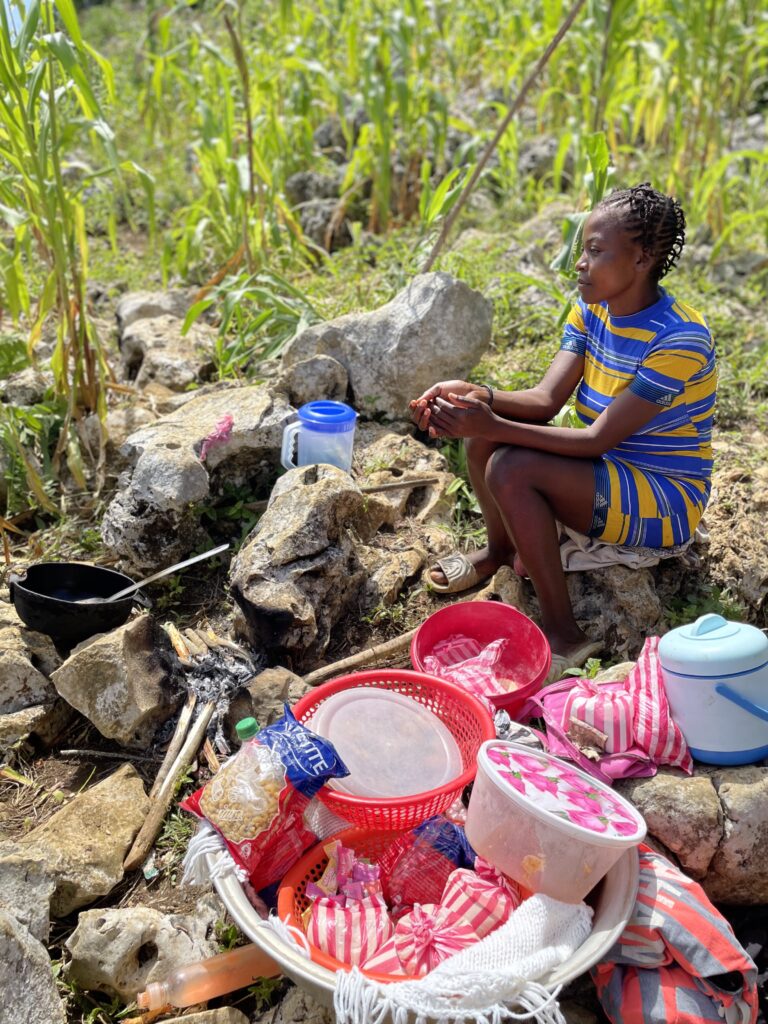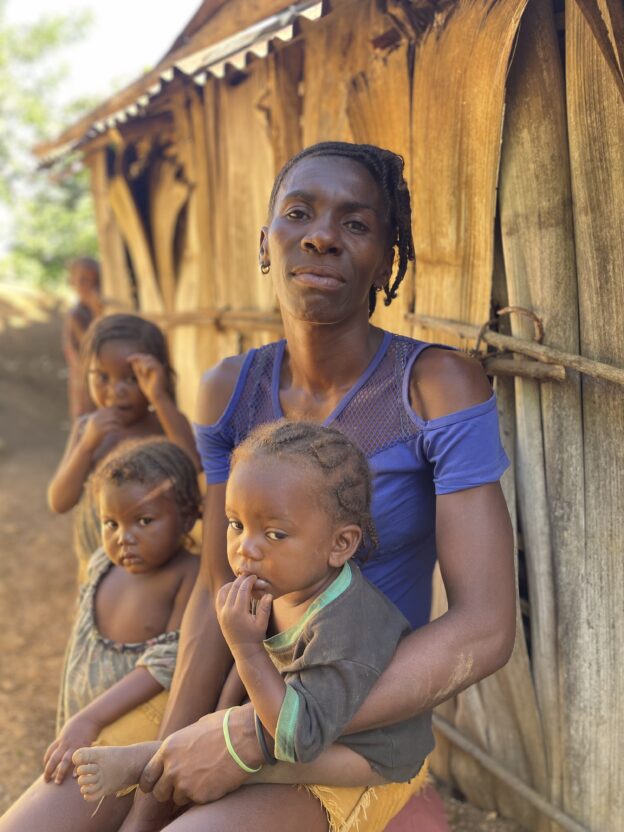Imanie lives in Woudobay, on the ridge between Laskawobas and Savanèt, just outside the larger mountaintop community of Gran Platon. Like many of her neighbors, she uses the market in Kolonbyè, a town in Savanèt, just as she uses the larger regional market in downtown Laskawobas.
She is originally from the Savanèt side of the ridge, and she was living around Fon Desanm with her first husband and their five children when the CLM team was working there about ten years ago. At the time, the family did not qualify for CLM. When that husband passed away, however, things took a turn for the worse for her. She eventually moved to Woudobay to live with her current partner, Osnel, with whom she has three additional children.
At first they lived well enough together, but she started to dislike the way that he treated those of her children who are not his. “I think his family put ideas into his head.” The three oldest decided to leave home, and they now live with their late father’s family. Three of the five who are still with her are school age, and she managed to send them this year, though she still owes the school money.
Before she joined the program, Imanie had a very small business. “I carried a washbasin [of products] on my head, selling whenever there was an event.” She sold tobacco, cigarettes, and local rum at events like wakes, cockfights, and parties. It is a business that requires a lot of hiking in a very rural area like the one where she lives. She would try to sell at home to save herself the effort, but that doesn’t work. “When you sell at home, people always want credit, so I would rather go to events.” The business does not take much capital. Imanie would borrow from friends to keep it going, and if she couldn’t do that, she’d turn to loan sharks.
Since she joined the program, however, she has started to turn her life in another direction. She found a neighbor willing to rent her a small plot of land “sou pri dacha.” That means that the rent she pays will count towards an eventual purchase. She made a 5,000-gourd payment towards the first year’s 17,500-gourd rent. She knows that she’ll have to pay 35,000 gourds for the first two years, but she’s not sure what the final purchase price will be. She’s already installed her CLM-supported latrine on the new plot. She wants to leave Osnel and move into her own home. She even thinks that her older children will want to return to join her.
Imanie has begun taking care of the goats that she bought with CLM funds. She has two mature females and a healthy kid. She does not yet have a clear idea what she wants to do with livestock. She simply explains that she wants to keep them “for graduation.”
She has begun saving in her VSLA, though she still depends mainly on her CLM stipend to do so. She hopes that, by the end of the year’s cycle, she’ll have enough between her savings and her livestock to buy a donkey. Having a pack animal would make a big difference for her. She could buy loads of produce at the rural markets that farmers use and bring them for sale to downtown Laskaswobas, where produce is more expensive.
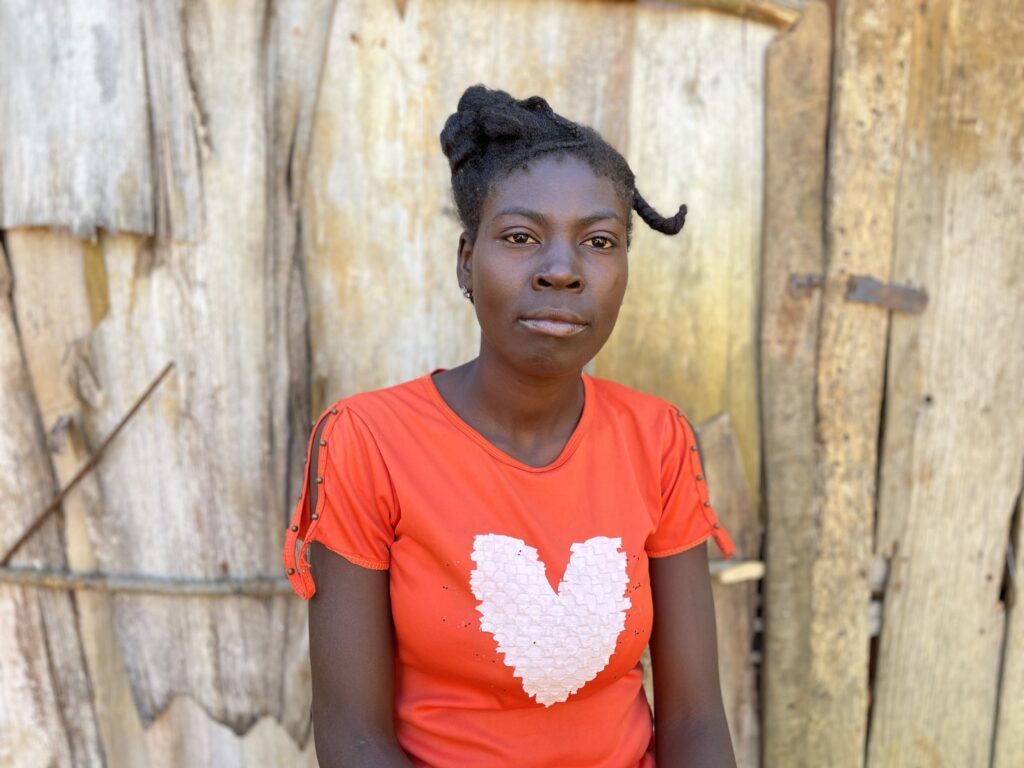
Anaphterline lives on the other side of a small mountaintop hill from Imanie with her husband Louiess and their two kids. She grew up nearby, just below Gwo Moulen, the next large-ish community to the east, and moved to Gran Platon when she moved in with Louiess.
Louiess has been the family’s main earner up to now. He works as a day laborer in local fields. The couple also has a small garden of their own, where they plant beans, pigeon peas, corn, millet, and what Anaphterline calls “lòt detay,” or other minor items, by which she means mainly plantains and meliton, or chayote, a squash-like vegetable common in Haiti. But it was not enough to keep them fed. “We sometimes went a day without food.”
Not that they had been helpless. Even before they joined CLM, they had purchased a house to set up on their land. They paid 25,000 gourds, and it involved selling multiple bean crops. Anaphterline adds that “the seller was really patient with us.”
But even after buying the house, they could not use it. It had to be disassembled where it stood on the seller’s land and then moved to where they live. “We bought the house, but we didn’t have the money to make food for the people who would help us move it.” Thanks to their CLM stipend, they finally had enough cash. It took four Sundays of work from four to eight movers, but the parts now sit, waiting to be assembled, where they live. “Louiess torn down our old house and put it back up in the corner of the yard so that we’d be able to put up the new house in the best spot.”
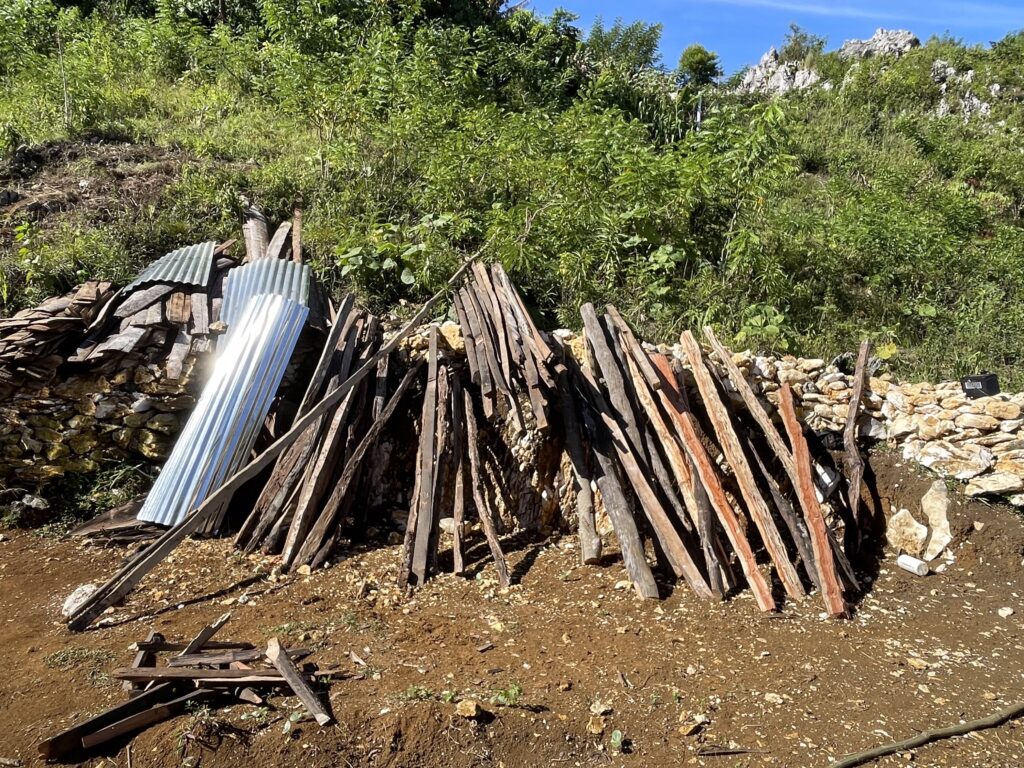
Anaphterline bought two goats with the first transfer of cash that the program provided. She had some money left over and plans to use it to buy a turkey. She expects to get the second transfer of the balance of her investment fund soon, and she will use it to start a small grocery business. “Louiess said he would build me a shack on the path that people use to hike to market, and I will run my business from that shack.”
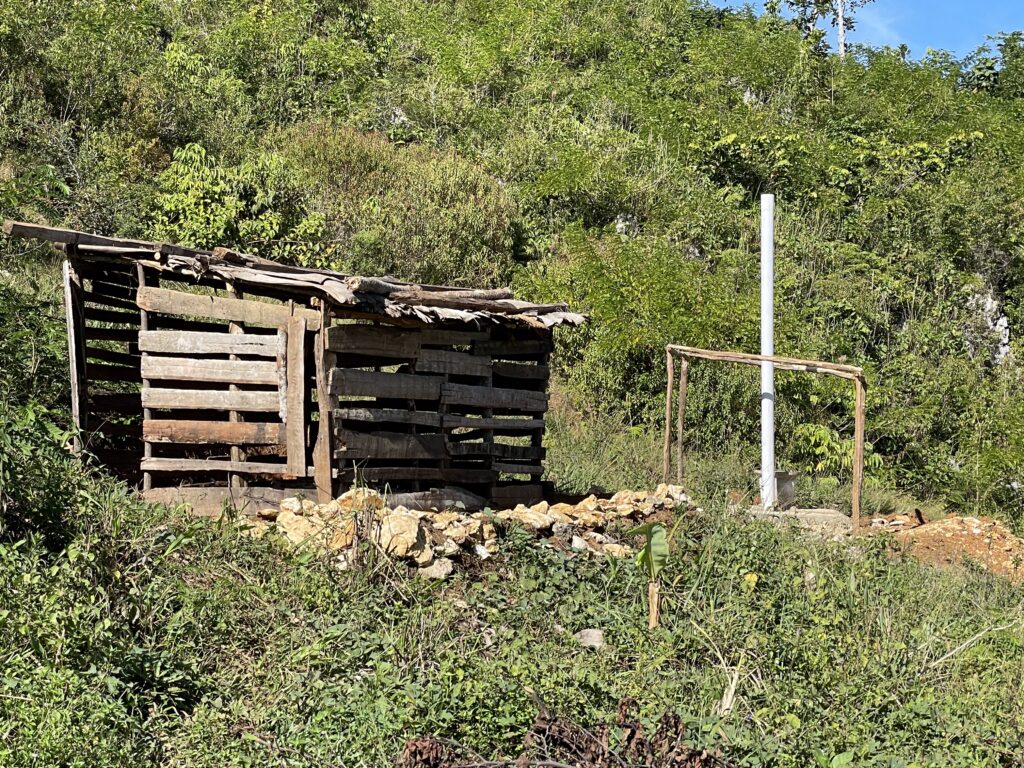
She hopes that, between her livestock and her commerce, she’ll be able to earn enough to buy a cow. “If you have a cow, you can buy land. When they see you have a cow, they know you can pay, so people who want to sell land will offer it to you.”
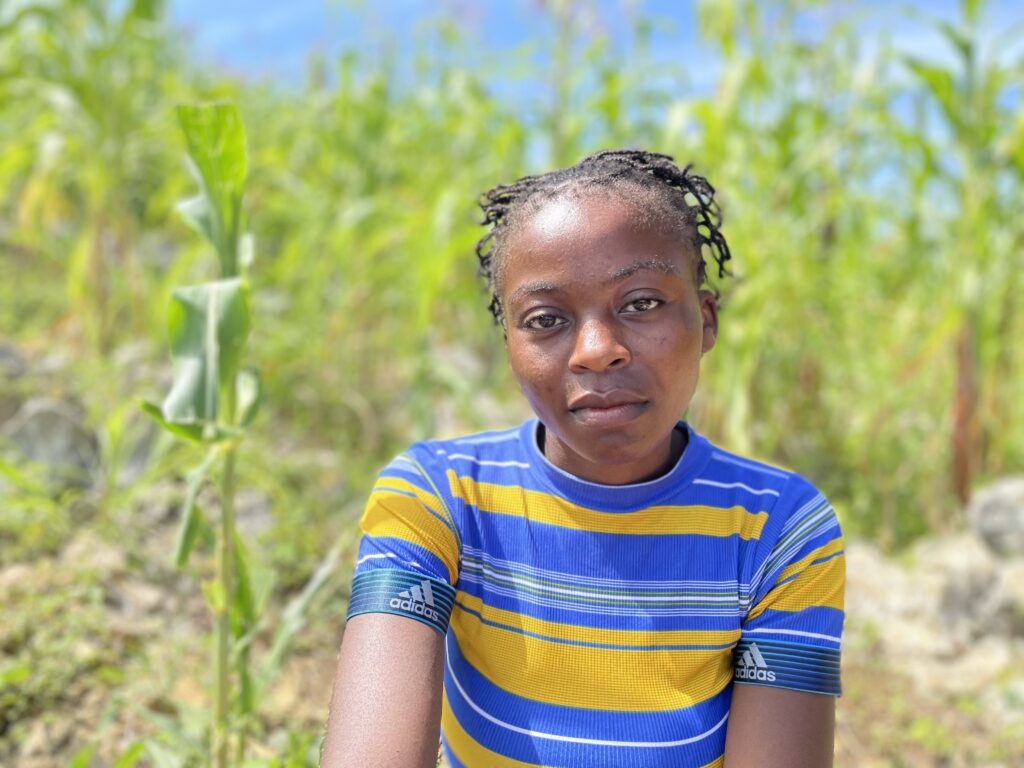
Dinah lives closer to the center of Gran Platon than the other two women. She lives with two small children in her mother’s house. The children’s father lives nearby, but he plays no role in their lives. She has an older brother working in the D.R. who sends their mother money as often as he can. Those transfers have been the household’s main source of income.
One priority for Dinah since she joined the program has been to get herself and her children into their own house, and she has gotten to work. She paid laborers to clean a flat spot on her family’s land for her to build a home on. She hopes to start building soon. She has already installed her new latrine there.
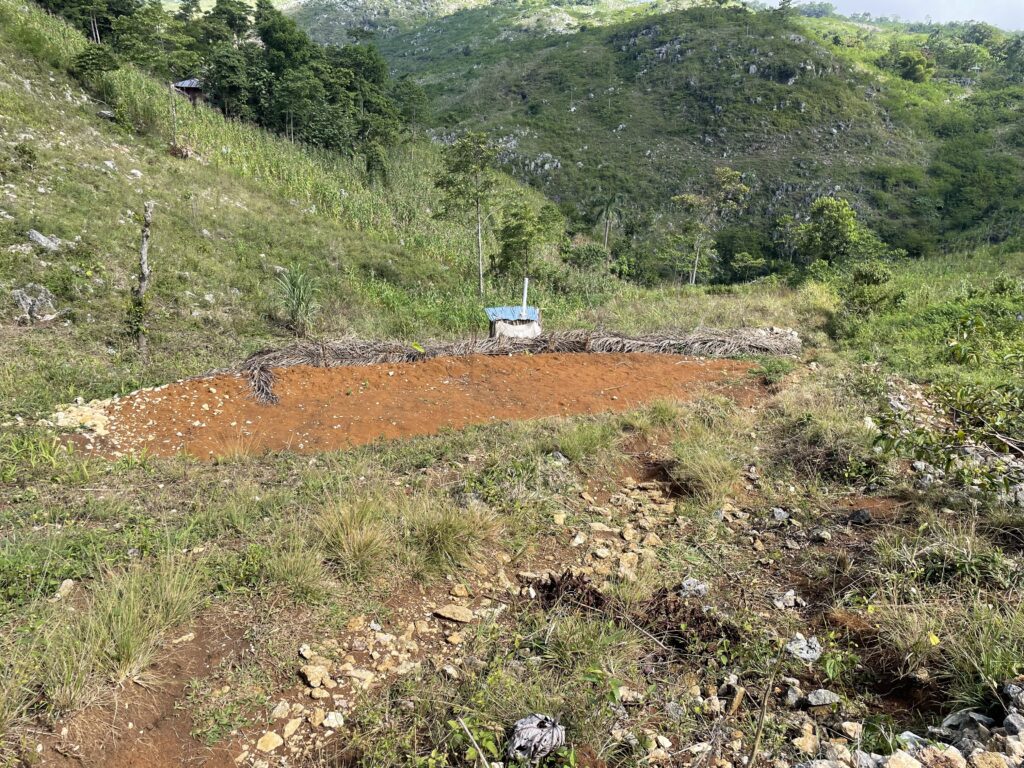
In the meantime, she has started her own grocery business on the main path using the stipend she received from the program. She sells a few basics and some fried snacks. She likes selling along the path because it means that she sees people as they come and go.
She also bought two goats with money from the program. Like Anaphterline, she hopes that the goats can someday enable her to buy a cow.
